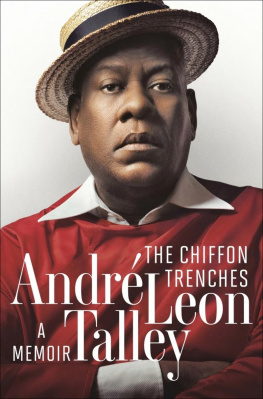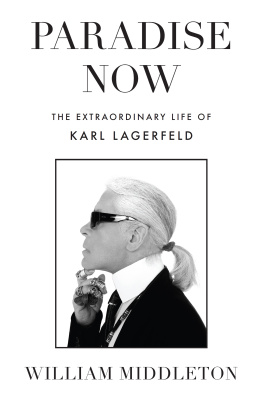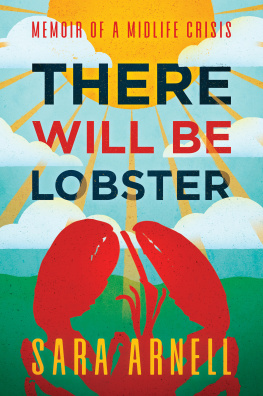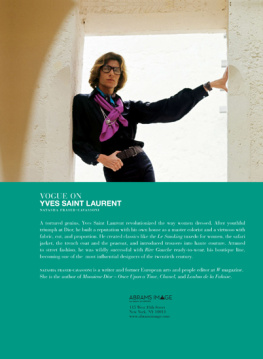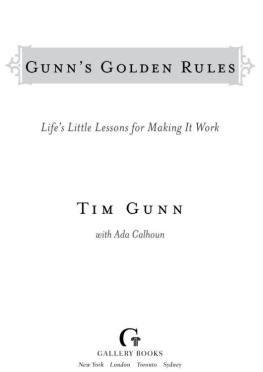
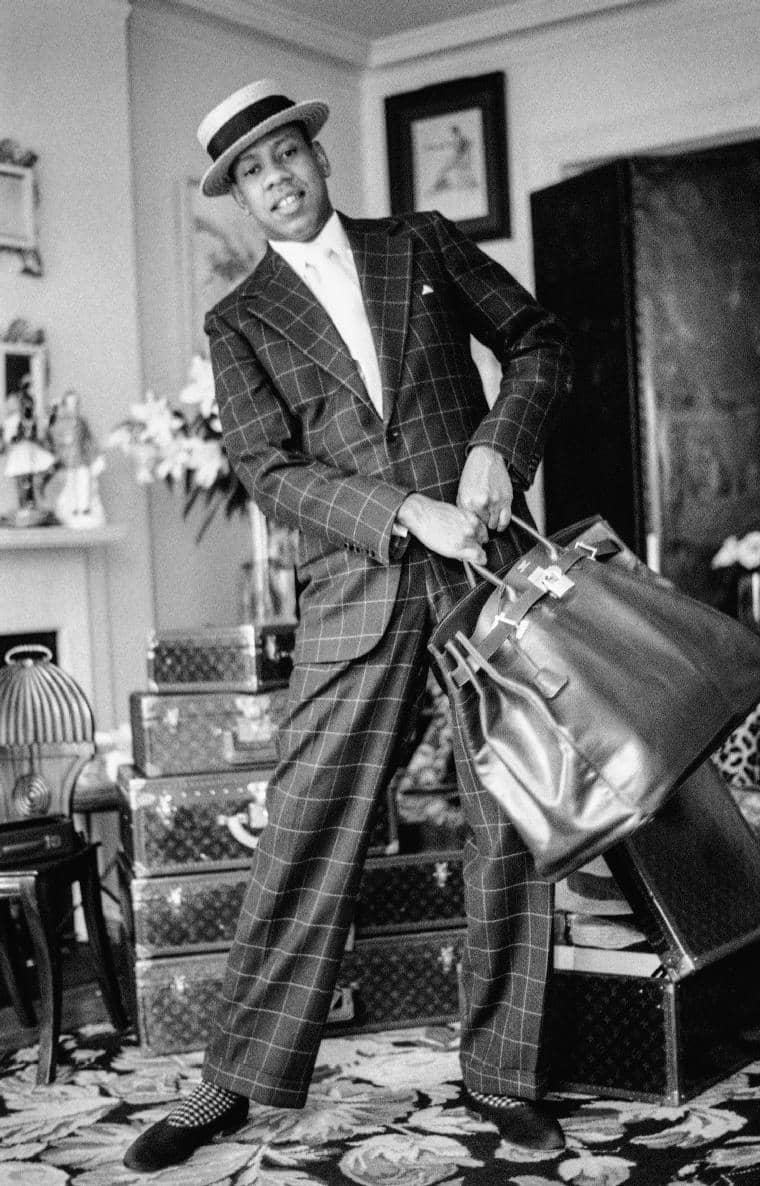
Photograph by Arthur Elgort
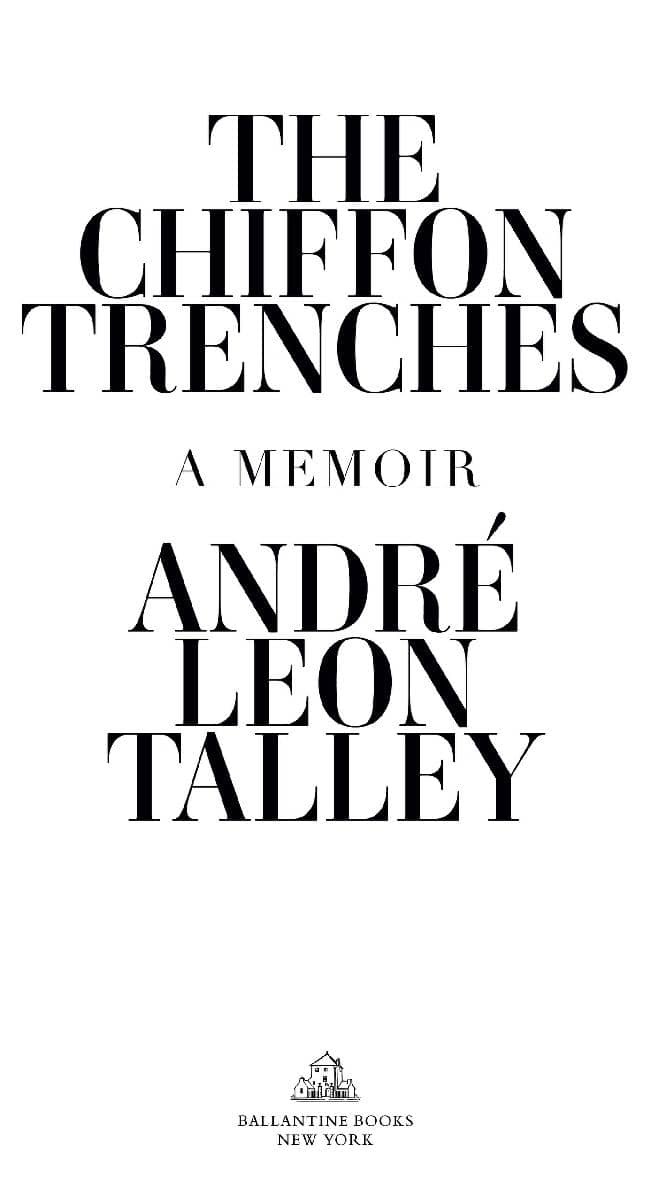
Copyright 2020 by Cornell Street, Inc.
All rights reserved.
Published in the United States by Ballantine Books, an imprint of Random House, a division of Penguin Random House LLC, New York.
BALLANTINE and the HOUSE colophon are registered trademarks of Penguin Random House LLC.
Library of Congress Cataloging-in-Publication Data
Names: Talley, Andr Leon, author.
Title: The chiffon trenches: a memoir / Andr Leon Talley.
Description: New York: Ballantine Group, [2020]
Identifiers: LCCN 2019055525 (print) | LCCN 2019055526 (ebook) | ISBN 9780593129258 (hardcover) | ISBN
9780593129265 (ebook)
Subjects: LCSH: Talley, Andr Leon. | Fashion editorsUnited StatesBiography. | African American fashion editors Biography.
Classification: LCC TT505.T29 A3 2020 (print) | LCC TT505.T29 (ebook) | DDC 746.9/2092 [B]dc23
LC record available at https://lccn.loc.gov/2019055525
LC ebook record available at https://lccn.loc.gov/2019055526
Ebook ISBN9780593129265
randomhousebooks.com
Book design by Elizabeth Rendfleisch, adapted for ebook Cover design: Roberto De Vicq
Cover photo: Colin Gray
ep_prh_5.5.0_c0_r1
Contents
Cover
Title Page
Copyright
Epigraph
Introduction
Best-Dressed List
Photo Insert
Dedication
Acknowledgments
Photo Credits
By Andr Leon Talley
About the Author
How I got over, how I got overMy soul looks back and wonders how I got over CLARA WARD
INTRODUCTION
For more than four decades, I went through a series of voyages with Vogue magazine and its editor in chief, Anna Wintour, the most powerful person in fashion. I was a fixture, a force, and a fierce advocate of fashion and style.
When I was an adolescent, Vogue was my inspiration. When other kids were tacking up baseball cards to their bedroom walls, mine were filled with the pages of the worlds most influential fashion magazine. To my twelve-year-old self, raised in the segregated South, the idea of a black man playing any kind of role in this world seemed an impossibility. To think of where Ive come from, where weve come from, in my lifetime, and where we are today, is amazing.
And yet, of course, we still have so far to go.
As I write this, I have just seen Beyonc Knowles-Carters September 2018 Vogue cover. It is, in some ways, another in a long line of fantastic images that made it through the meticulous process of becoming the cover of Vogue.
And then, in other ways, it stands alone.
This picture, and what it represents, is hugely important and significant. When you look at this cover and you know that Anna Wintour, whose exquisite taste has defined Vogue for decades, gave Beyonc creative control of her cover and cover story, then you start to understand its importance. And it was the September issue, the biggest issue in the yearly lineup! Beyonc is an incredible tsunami of talent and power. She cannot be defined through the cultural standards that define Vogue; Beyonc defines herself.
When I first saw this cover, I knew it was history in the making. Chosen at Beyoncs suggestion, photographer Tyler Mitchell, at only twenty-three years old, became the first black man to shoot a cover image in the 125-year history of one of the most prestigious magazines to ever exist.
Beyonc stands out on a lawn somewhere outdoors, no big expensive studio.
Theres a flowing white sheet on a line, like laundry, as a backdrop.
Besides the rococo fresh flower arrangement on her head, Beyoncs dressed simply, in a long Gucci dress. Her makeup, natural. Her skin moisturized and her knees exposed, and firmly together. No apologies or nuance or overt sexuality.
That image conjures for me laundry drying in the fresh open air. Mitchells photograph suggests the laundress, that bygone station, delivering white linens to the white masters big white house. Crisp, immaculate whiteness. Cicely Tyson in the film Sounder, making money to feed her sharecropping family; my great-grandmother and grandmother, doing the weekly laundry, backs bent and weary in fatigue, just another duty in line with their responsibility for the cleanliness is next to godliness creed that is part of humble living.
In all its elegance, the sheet symbolizes so many black women, in their own confident beauty, who did laundry to survive, to provide for their families, to put food on the table. I find it subtly very black. Basic and black. Black with style.
As Mitchell so aptly pointed out in a Vogue interview about the shoot: For so long, black people have been considered things.
I see the influence of Kara Walker, Alice Walker, and Zora Neale Hurston, along with the unnamed armies of black mothers and maids working for whites to keep food on their own tables. Thats amazing to me. The scene is fresh, unprecedented, and without parallel in the history of Vogue fashion covers.
Knowledge is power.
Fittingly, in the corresponding pages of Vogue, Beyonc writes of exploring her roots and learning shes the descendant of slaves. That is evolution. That is revolution.
She describes how she fought to get her body back after her first child, and how with the twins she embraced her FUPA, her little baby stomach, and how her arms are bigger and shes embraced that, too. As a black woman, she is going to inspire people.
The only other time Beyonc was on the cover of Vogue, there was no story inside.
She wanted to interview herself, and that was not allowed. And now this time, in 2018, she had full control of her story, suggesting the first black American photographer for the cover and writing her own narrative inside the issue. Beyonc can do that because shes the most popular woman in the world. And she chooses to do that becausewhy? I suspect because she knows what all black people know: Its difficult to be a black woman or black man in this country.
We struggle to endure and overcome the centuries of ingrained white supremacy, the institutions of injustice and inequality, in every aspect of life in this, the great America.
I proudly wrote an op-ed for the Sunday edition of TheWashington Post about the cultural significance of Beyoncs cover. Upon its publication, I sent a link to Susan Plagemann, the publisher of Vogue. She was thrilled with the piece and sent it off to every major editor in the Cond Nast lineup, including Anna Wintour.
Not one of those editors wrote me about the piece. Not one quick e-mail from Anna Wintour.
Editors Ive worked with for decades didnt understand the immense importance of this occasion simply because they are not capable of understanding. None of my contemporaries have seen the world through black eyes.
For so long I was the only person of color in the upper echelons of fashion journalism, but I was too busy pushing forward, making it to the next day, to really think about the responsibility that came with this role. Memories linger in the mind. Now I realize it is my duty to tell the story of how a black man survived and thrived in the chiffon trenches.
Next page
